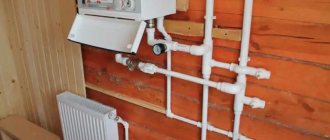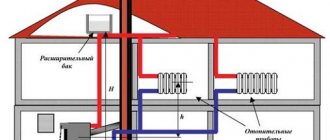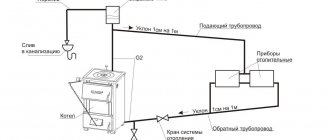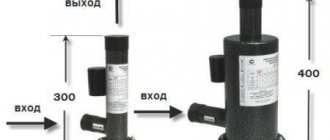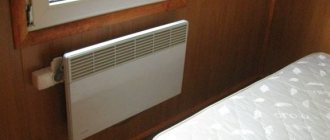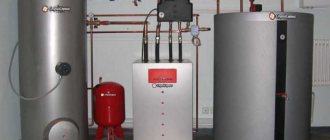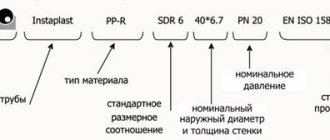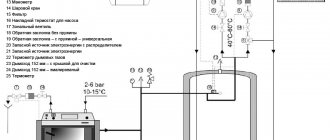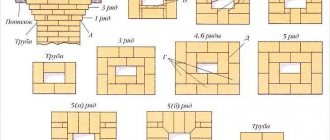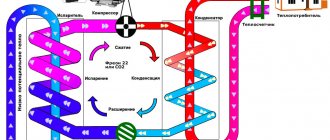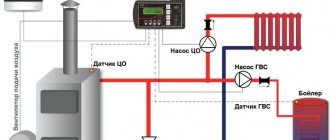Heating system with solid fuel boiler
How comfortable is a solid fuel heating system to use? In addition to the fact that heating systems with a solid fuel boiler are not inferior in the comfort of use to conventional, more popular systems, they are also much more economical. In the installation diagram of a solid fuel boiler, in a solid fuel heating system, the following elements are used:
- Boiler - heat generator
- Accumulator - this element takes care of the uniform combustion of fuel, for its most efficient combustion. The storage tank has a very important function: even after fuel combustion, it releases accumulated heat into the system, which generally stabilizes the operation of the entire system. Depending on the type, it may contain a tank to meet the needs for large volumes of water, for example for taking a bath. Also, depending on the configuration, the tank may have an additional heating element - a heater. During peak loads, it supports the system by helping to heat the water. There are also small electric boilers that are installed directly on the flow pipe, with the same purpose - to support the main boiler during peak loads and prevent the water from quickly cooling after the fuel burns out. After all, maintaining the temperature requires less energy than for initial heating.
- Thermostatic mixer - controls a stable temperature by mixing hot (already heated) and cold water.
- A circulation pump with a thermostatic valve controls that the temperature difference between the supply and return is not more than 10 C. There can be a wide variety of types of thermostats for this task.
- Expansion tank - regulates the pressure level in the system so that in the event of a temperature difference, the system simply does not burst; the expansion tank receives and releases water from the system, depending on the situation.
- Chimney - serves to remove combustion products outside.
- Radiators or a heating circuit in the floor (warm floor) - a scheme of a heated floor or radiators, directly produce heating, releasing heat evenly throughout all rooms.
Solid fuel boiler piping
A solid fuel boiler rarely includes a circulation pump, automation, or a safety group. The owner purchases all this himself, guided by the characteristics of his heating system.
Regardless of the type of wiring, the pipeline should be equipped with safety devices (see below). The second stage is to ensure the functionality of the system and comfort during its use. A couple of devices worth mentioning here:
- heat accumulator. Thanks to its operation, there will be no sudden temperature changes in the house during the boiler reboot process. This is a large volume tank that is installed between the boiler and the system on the supply pipe. To regulate the temperature at the outlet of the tank, install a mixer with a three-way valve;
- an indirect heating boiler for domestic hot water is connected in parallel to the heating system. They are equipped with a mixer and their own pump so that when moving from the boiler to consumers, the water does not have time to cool down.
Connecting a boiler with a heat accumulator
Whether or not to purchase a pump if DHW is not provided depends on the wiring. Let's consider its main types.
Types of solid fuel boilers
Types of solid fuel heating boilers differ in the type of fuel:
- firewood;
- coal;
- pellets and briquettes;
- peat;
- wood processing waste;
- universal boilers with two or more fireboxes.
Calorific value of solid fuel
In addition, there are combined models for two or more energy carriers: wood + electricity, wood/diesel/gas, etc. Their purchase is justified if:
- In your area, the two energy sources are equally available and inexpensive. If you run out of firewood, switch to gas; if there are power outages, switch to firewood, and so on;
- in order to save money. For example, if you have a two-tariff payment for electricity, heat with wood during the day, and at night (when electricity is cheap) switch to fully automated electric heating.
Pellet boiler
- with top ignition. When the flame spreads from top to bottom, the filling burns out more slowly;
- with an extended firebox and limited air supply. Horizontal flame propagation is also slower. By reducing the oxygen needed for combustion, you reduce the intensity of the flame;
- pyrolysis chambers are equipped with two chambers: in one the fuel burns, in the second the gases released during combustion are burned. The thermal efficiency of these units is the highest, but they are also more expensive than others.
Main types of boilers
As a rule, we buy boilers for our home that are capable of converting fuel into heat that we can afford to buy. Today, several types of fuel are used to generate energy:
- coal,
- firewood,
- peat (peat briquettes),
- pellets,
- briquettes
If the equipment you purchase is of very good quality, then it will be able to absorb a lot of types of fuel, which will help you save a lot in its further use. And heating a house with a solid fuel boiler will only bring joy.
Heating a house with a coal boiler
If you cannot decide which boiler you need, but live far from the city where there is no opportunity to use “state heat,” then it is better for you to purchase a coal boiler. In this case, the best choice. Some of the important advantages of heating a house with a coal-based solid fuel boiler are its versatility, low price and, of course, independence. After all, you don’t need to constantly look after it, but only check for combustion from time to time. Of course, if the boiler is good. It can also use different types of fuel.
Heating the house with a wood and pellet boiler
Such a boiler is very often purchased because it has many advantages in use:
- highly efficient;
- economical;
- powerful (up to 200 kW);
- high efficiency (efficiency), which can even reach 90%;
- good burning time;
- full use of fuel;
- You can install a loading hopper.
Wood for heating today is very affordable, because it can be purchased in any corner of our country at a low price.
Heating with pyrolysis boilers
Heating a house with such a solid fuel boiler is generally also a good option. Such devices are capable of processing biological fuels (for example, agricultural or wood waste). During combustion, fuel emits flammable gas, which can burn for a long time and produces a fairly large percentage of heat.
The efficiency of a pyrolysis boiler, as a rule, reaches 84-92%.
If you live in an area where you do not have the opportunity to connect to the power grid, then you should think about an autonomous boiler with solid fuel and manual load. It is very reliable and does not give unexpected failures.
Step-by-step installation progress
Any instructions supplied with the boiler contain recommendations for installing the equipment. Installation of a solid fuel boiler must be carried out strictly according to the manufacturer’s instructions and technical rules.
The sequence of actions must be followed.
Base
First, you should build a solid base of non-combustible material under the bottom 20 cm wider than the base of the unit; it is best to pour a concrete base. After this, you need to install the boiler on a solid base, taking into account all distances, and adjust the horizontal and vertical positions of the device.
Connecting pipes and safety elements
Adhering to the connection diagram, insert a complete safety group for this type of boiler, which is installed up to the shut-off valves.
After this, the heating pipes should be connected, it is advisable to make the connection through shut-off valves, and carefully seal the joints with flax or plumbing tape.
Chimney
Next, you need to assemble a chimney, good draft in which depends on the correctly selected cross-sectional area and height of the pipe; all connections must be coated with heat-resistant sealant.
Final stage
At the next stage, you can fill the heating system with water at higher pressure and check for leaks. After which it is necessary to check the location of the grates, dampers, plugs, and fireclay stones. At the end of the installation, you need to reduce the water pressure to working pressure, install dampers in the chimney and firebox, and load firewood.
Now you can light the boiler, when the design temperature is reached, turn on the thermostat to the selected heat supply level for comfortable heating of the room and do not forget to add firewood to the firebox in a timely manner.
Connection with an electric or gas boiler
Often, homeowners purchase a solid fuel boiler as the main source of heat, leaving the existing gas or electric unit in reserve. Usually it looks like this: while the owner of the house is awake, he devotes time to the wood-burning heat generator, and at night a different type of heater is turned on. It would be a sin not to connect these two boilers in such a way that the system works automatically, that is, when the firewood in the firebox dies out, the electric heater comes into play.
Of course, the most effective way to work will be a parallel connection of a gas and solid fuel boiler through a buffer tank. The latter will simultaneously perform 2 functions: serve as a hydraulic separator and a heat accumulator.
While all heating systems operate from a heat generator using wood or coal, the gas boiler is in standby mode. But when the fuel in the chamber burns out, the temperature of the water in the buffer tank will begin to decrease. This will automatically start the burner of the gas unit, since its circulation pump is constantly running. It will deliver the cooled water to the temperature sensor, which will start the main burner through the controller. When the firebox is ignited, the reverse process will follow; the gas burner will turn off due to the high temperature of the coolant.
It should be noted that the connection diagram for a solid fuel boiler with an electric boiler through a buffer tank will be absolutely identical. But it has a significant drawback - high cost. This heating system arrangement is relevant for large private houses; for small buildings there are simpler solutions:
Both boiler systems are switched on in parallel, with check valves installed at the outlet of each. Since the pump in an electric boiler is built-in, runs constantly and cannot be turned off, you need to choose the right pump for a solid fuel heat generator. The pressure of the latter must be higher so that when working together it has priority over the electric boiler.
This connection of an electric boiler to a solid fuel boiler will function automatically if two devices are installed:
- thermostat that controls the operation of the biomass heat generator pump;
- room temperature sensor that controls the electric boiler.
While burning wood, the room sensor will record the normal temperature in the house, so the electric heater will not turn on. But as soon as the fuel burns out, the air in the room will begin to cool, as will the coolant in the pipes. When the water temperature drops, the pump thermostat will turn it off, and the sensor will turn on the electric heat generator. More detailed information can be obtained by watching the video:
Making a wood-burning boiler with your own hands
Homemade boiler
Is it difficult to make a wood-burning boiler for your home with your own hands? The main condition for this design is the thickness and grade of steel used. In factory models, the outer casing is made of heat-resistant steel with a thickness of 1.5 mm. For a heat exchanger, these parameters should be larger - from 2 mm.
The best option is to create a welded structure, which will be similar in shape to the factory models. However, if you calculate the labor intensity of the work and the cost of materials, the difference between purchasing and making it yourself will be small. Therefore, as an alternative to wood stoves for homes with water heating, simple steel barrels are often used. The main condition is the thickness of their walls - from 1.5 mm.
For production you will need a container of about 200 liters. It is cut lengthwise and a partition is installed inside. Its length should be less than the length of the barrel. This is necessary for the installation of grates.
Then holes are cut on the end side for mounting the doors. They should be selected in advance so as not to make a mistake with the sizes. To remove carbon monoxide, a chimney pipe is cut into the back of the structure. Its diameter can range from 50 to 100mm.
However, judging by the reviews of such a wood-burning heating boiler, the following disadvantages can be noted:
- Low efficiency rate;
- Heating of the case, which can lead to burns when touched;
- Short service life.
Similar designs are used for heating small utility rooms - garages, warehouses, etc. For your home, it is best to purchase a high-quality factory model. It will fit modern wood heating schemes.
| Boiler model | power, kWt | Cost, rub. |
| Buderus Logano G221 | 20 | 69900 |
| Dakon DOR F 24 | 24 | 60300 |
| Proterm DLO 30 | 24 | 58450 |
Gas heating system diagram
The heating system of a private household running on gas necessarily includes a boiler, batteries, an expansion tank, a circulation pump and connecting pipes.
The coolant heated by the boiler circulates through pipes and radiators, giving off its heat to the environment and returning again to the main heating unit. The movement of water is usually ensured by a forced method due to the pressure pumped by the pump. To increase the efficiency of water gas heating at home, its circuit can be supplemented with shut-off valves, Mayevsky taps, a temperature sensor and other elements. The expansion tank is an integral component of any heating system, both with forced and natural circulation.
The gas heating scheme with natural circulation of water is due to the peculiarity of installing the pipeline at the required angle, as well as the use of pipes with a large diameter and the installation of an expansion tank at the highest point of the system. In this case, the heating wiring diagram can be performed in two ways:
- Beam method, which is easy to carry out repair work, as well as high efficiency. But you will have to spend money on pipes due to the large size of the pipeline.
- The tee method is slightly cheaper due to the smaller number of pipes. But it will not be possible to adjust individual heating elements, since this is simply not provided for in the circuit.
If the heating system is connected directly to the central gas pipeline, then human intervention in its operation will be limited to changing the temperature parameters.
Inclusion of solid fuel boilers in the heating system
It is possible to include a solid fuel heating device both in a gravitational system and in a circuit with forced circulation of coolant. The “inclined” heating scheme for a private house with a solid fuel boiler without a pump requires a minimum cost of materials, since it includes fewer components. However, it initially assumes experience in the construction of such systems. The slope of the system must correspond to 0.05 degrees along the entire length of the contour. It is necessary to use a pipe narrower when connecting each subsequent radiator. For example, if the central main pipe has a diameter of 1 inch, then the first radiator is connected without narrowing. The second one is “pressed” - ¾ inch, and the third ¼ inch. In this case, excess pressure is created, and the water circulates by gravity, without a pump. The top point of the circuit is the expansion tank, and the diagonal option is chosen as the method of connecting radiators to the system.
Important : it is recommended to use this circuit only in cases where frequent fluctuations in electricity are possible. In general, the gravity system is considered obsolete, but it is completely independent of electricity.
A more modern scheme, actively used for all types of heating boilers, includes a circulation pump. It is installed on the return line and “drives” the coolant along the circuit. In this case, it is recommended to choose a two-pipe heating system for even faster and more efficient recirculation. And the security team will protect you from an emergency. It is recommended to divide the heating circuit into one or two zones, which directly depends on the number of radiators.
Modern solid fuel boilers work perfectly in underfloor heating systems, which allows them to fully replace gas and electrical equipment. But even “safe” fuel does not exclude precautions, and connecting to heating requires certain knowledge. Therefore, without experience, you should not do it yourself.
Heating system installation
Installation of the heating system of a country house is carried out in several stages:
- project development, obtaining permits from the relevant authorities;
- purchase of materials, equipment and preparation of tools;
- insertion into a gas pipeline that runs along the street and through which gas is supplied to residential buildings;
- preparing a place for a gas boiler, laying out pipes;
Installation of gas equipment
boiler installation; filling the system with coolant; diagnostics.
The main criterion by which the amount of materials is calculated and the model of heating equipment is selected is the area of the house. The larger it is, the more powerful the device will be needed. For a small house, a small-sized boiler is suitable, which can be installed in the bathroom or kitchen. For a cottage or two-story mansion, it is better to choose a large, powerful device.
A heating system in a private home installed in accordance with all the rules will function for a long period. Before starting installation work, you should familiarize yourself with the heating diagram and the rules for installing heating equipment.
Advantages of thermal accumulators
The mechanism of operation of the thermal accumulator
The heat accumulator can fully replace the hot water boiler. Moreover, both devices are comparable in cost.
However, the heat accumulator will not only provide hot water supply, but will also solve a whole range of additional problems. By using a solid fuel boiler with a heat accumulator, you can get many advantages:
- the service life of heating equipment increases several times;
- the boiler will never operate at maximum loads or idle;
- the temperature of the heating supply to the house is equalized. If the water in the boiler does not have time to heat up, hot coolant is automatically supplied from the reserve tank. Conversely, excess temperature of the carrier will be selected and accumulated;
- a correctly selected container continues to take heat from the boiler even with complete combustion of the fuel;
- resource savings reach 30%.
The advantages of batteries have been appreciated by many manufacturers of solid fuel boilers. And now they provide their equipment guarantees only if additional tanks are installed.
Solid fuel boiler with heat accumulator
Heating a home with a solid fuel boiler using coal and wood is very popular. But in order for the heat not to go anywhere, it needs to be accumulated. Sometimes a water heated floor with a fairly large thickness of concrete is used to retain heat.
But it is also very effective to use a large tank of water that can insulate the heat. Such a tank is connected between the boiler and the heating system. Using a circular pump, the boiler heats the water and then it is supplied to a special tank. After the water cools, it goes back into the boiler. There is also a second pump in this system, which “drives water along the top and bottom of the tank.
A similar tank is installed to perform the following functions:
- Heat accumulation and release as needed;
- Boiler overheat protection;
- Automatic heat distribution;
- It is a connecting element of any type of boiler with a heating system;
- Can ensure combustion of fuel materials with maximum efficiency;
- Increased burning time;
- In some cases, water consumption.
Calculation of the volume of a membrane expansion tank
A closed heating system, in which the coolant is under pressure above atmospheric pressure, has more advantages. In this case, to compensate for the thermal expansion of water, instead of an open expansion tank, a closed membrane expansion vessel is used (shown in the diagram as a dotted line to the left of the boiler).
The expansion tank is divided into two parts by an elastic movable membrane. One part of the tank receives coolant from the heating system. On the other side of the membrane in the tank there is compressed air. Air pressure balances the pressure of the coolant in the heating system. As the temperature and volume of the coolant increase, the membrane in the expansion tank moves, increasing the volume occupied by the liquid. The air on the other side of the membrane is compressed even more.
The expansion membrane tank can be horizontal or vertical. There are also those in which the membrane can be replaced, but this is not possible.
How to choose the right expansion tank volume
The volume of the membrane expansion tank is calculated using the formula: V = (VLxE) / D;
VL – total volume of liquid in the heating system;
E – liquid expansion coefficient, for water at a temperature of 85°C = 0.034;
D – efficiency of the membrane tank, calculated by the formula: D= (PV-PS)/(PV+1).
Where PV is the maximum operating pressure of the system, usually 2 bar is sufficient, PS is the charging pressure of the membrane tank, equal to 0.5 bar.
Thus, D=(2-0.5)/(2+1)=0.5
If, for example, the volume of coolant - water in the heating system of a house is about 450 liters, then the volume of the expansion tank will be equal to:
V = (450x0.034)/0.5 = 30.6 l.
Selecting the correct boiler size, i.e. its heating power is a very important condition for economical operation and proper functioning of the boiler. The boiler must be selected so that its rated heating power corresponds to the heat losses of the heated object. Choosing a boiler with a rated power that is too high can lead to increased formation of deposits (soot, tar). Therefore, you should not use a boiler that has a significantly higher power than the heat loss of the facility.
The approximate heating capacity of the boiler can be calculated as follows - for every 10 m2
heated area of the house with average insulation of the building and ceiling height up to 3
m
. 1 kW of power required.
It is useful to familiarize yourself with the operating instructions for the solid fuel boiler. The operating instructions for solid fuel boilers “Atmos” (Czech Republic) can be read and downloaded by following this link. To download, in the window that opens, in the menu at the top left, select “file” -> “download”.
Heat accumulator with insulation
Heating equipment that runs on solid fuel is today an excellent alternative to gas. Well-thought-out and professionally designed piping significantly increases the service life of the unit. Among the different connection options, connecting a heat accumulator for a solid fuel boiler has become very common. This scheme allows for significant savings and relieves stress from the heating device during peak loads.
Choosing a boiler
Once you have decided on the fuel that will be used for solid fuel heating of a country house, you should choose a boiler. Conventionally, boilers for solid fuels can be divided into the following groups:
- classic;
- automatic;
- pyrolysis;
- long burning.
Classic boilers
Classic boilers imply the following operating principle: solid fuel burns in a flame to produce heat, as is the case with a regular fire. Combustion is optimized by a special grate to supply combustion air from below. And the amount of this air is regulated by the settings of the scraper and the supply of air mass to the combustion chamber manually. Fuel is loaded through the top door, and ash is removed and combustion is regulated through the bottom door. The boiler heat exchanger can be made of steel or cast iron. Advantages of classic boilers: the ability to operate on 2 types of fuel (minimum), often it is also possible to install a gas or liquid fuel burner, independence from energy. Among the disadvantages: frequent loading of fuel is required, a place for storing fuel and a separate room for the boiler room are also needed.
Diesel heating of a country house
Classic solid fuel boiler
Pyrolysis boilers
Pyrolysis boilers use gases from fuel decomposition for combustion. This is due to the effect of high temperature with insufficient air. The structure of the boiler includes two chambers, which are separated by grates: the lower one for loading and the combustion chamber.
The combustion process here is as follows: fuel is added and ignited, the combustion chamber door is closed. In the upper chamber, a boost fan is activated, which serves to mix the smoldering air of the lower chamber with clean air. The mixture begins to ignite and directs the fire to the fuel through ceramic nozzles. Without access to oxygen, the fuel is burned - this is how pyrolysis occurs, that is, the decomposition and gasification of the fuel. So, the process will continue until the fuel is completely burned. This is how solid fuel heating occurs. Advantages of pyrolysis boilers: high efficiency (up to 90%), fuel burns on one load for up to 10 hours, reduced requirements for the chimney, high level of environmental friendliness. Disadvantages: high cost, dependence on energy, unstable combustion with partial load, very high requirements for dry firewood, etc.
Pyrolysis boiler
Automatic boilers
Automatic boilers - processes such as fuel loading and ash removal are automated here. Boilers of this type have an automatic fuel supply hopper - conveyor or auger. For stable combustion, the fuel must be uniform in composition and size. The advantages of such boilers: high efficiency (up to 85%), operating time, limited capacity of the bunker designed for automatic supply, and fuel homogeneity provide the ability to fine-tune the combustion process. Among the disadvantages: high price, dependence on energy, the need for a separate room, a separate fireproof ash receptacle, as well as qualified maintenance.
Automatic solid fuel boiler
Long burning boilers
Another type of boiler that is used to heat a country house with solid fuel is long-burning boilers. Here, long-lasting combustion is maintained using special techniques. Such combustion can be ensured by two systems: the Canadian Buleryan boiler system and the Baltic Stropuva boiler system. Buleryan is a two-chamber wood-burning stove, which is divided horizontally. Smoldering takes place below, the gases go to the upper chamber, where they are mixed with secondary air through a nozzle, after which the fuel is burned. Stropuva is a high barrel up to 3 m high, filled with firewood and covered with a movable lid with a chimney. First, the wood is set on fire, after which it burns sparingly, heating the coolant along the jacket of the barrel; the air supply is regulated automatically.
Heating a country house with wood
Long burning boiler
Criteria for choosing a gas boiler
For the simple reason that a gas-fired boiler is the central unit of the heating system, its choice should be made with full awareness of the issue. Thus, purchasing a device with a closed combustion chamber does not require the installation of an exhaust gas exhaust pipe. If there is no central gas supply near a private house, you can opt for a combination boiler that runs on different fuels.
The parameters of a gas boiler may vary depending on the size of the heated room. Gas appliances can be either low-power for heating single-story buildings, or powerful boilers capable of heating a multi-story building or even an industrial facility. Depending on the functionality, gas-fired boilers are divided into single-circuit and double-circuit units.
Single-circuit gas equipment is intended only for heating the house. In turn, the dual-circuit analogue, in addition to its direct purpose, has the additional function of heating water. Moreover, such devices are flow-through and storage. But the use of a flow-through device is advisable when the consumption of hot water is insignificant. In turn, a double-circuit boiler with a built-in boiler is capable of fully providing both heating of a private home and hot water supply.
If we consider the types of gas burners, they come in atmospheric and ventilation operating principles. The atmospheric burner is the most common in heating systems for private housing construction. The ventilation burner is installed in boilers used in industrial structures. Boilers also differ in the type of draft for natural and forced exhaust gas removal.
Depending on the installation option, gas appliances are divided into wall-mounted and floor-mounted units. The floor-standing boiler has large power ratings and device dimensions, as well as high durability. A wall-mounted gas boiler is more compact, but the maximum power of the device is limited. In addition, the wall-mounted device has a shorter service life.
Operating rules for solid fuel boilers
The heating system in the house is a complex mechanism that must be monitored and strictly followed all operating and safety rules if you want to use it for a long time and effectively.
Chimney
For normal operation of the heat generator, it is necessary to build the chimney very carefully and correctly.
Chimney pipe:
- made from fireproof, heat-resistant materials that are not susceptible to corrosion;
- necessarily with insulation made of basalt mineral wool to avoid the formation of condensation;
- pipe cross-section - from 150 to 300 mm, depending on the power of the fuel unit;
- pipe height - from 6 to 10 meters;
- The inner walls of the pipe must be smooth, without irregularities or roughness.
Warning:
- before the start of the heating season, inspect the chimney: suddenly something got in there over the summer;
- After the end of the season, be sure to clean the chimney of soot and soot, otherwise the soot in the chimney may ignite.
Sometimes it turns out that there is a very strong draft in the chimney, then they resort to using a throttle valve.
Heat generator
It is very important to correctly fire up the unit for the first time. During manufacturing, the heat generator is treated with special oils, so when it is first lit, an unusual smell appears - this is the oil burning out. Nothing bad happens: you need to constantly ventilate the room for an hour, the oil will burn out, and the unit is ready for further use.
It is necessary to load the fuel chamber with the ash pan closed, filling the furnace to the limit.
To maintain the efficient operation of the unit for a long time, it must be cleaned regularly. Soot can block the exit to the chimney and reduce draft, or it can simply ignite on its own, releasing carbon monoxide. Clean the completely cooled unit; this procedure must be carried out regularly once a month.
Prohibited:
- install any shut-off equipment between the heater, the safety group and the expansion tank;
- operating the heat generator with open doors;
- melt the unit without water or other coolant in the system;
- ignite fuel using fuels and lubricants: gasoline or diesel fuel;
- flood the unit if there is poor draft in the pipe;
- leave the operating unit unattended for a long time;
- leave flammable objects on the surface of the device: paper, newspapers, rags;
- Small children should not be left unattended near an operating heat generator;
- in the spring, when you stop heating the boiler, you definitely need to do maintenance: clean it and lubricate the moving parts of the mechanism.
Fuel
The choice of fuel is a very serious problem and must be approached responsibly.
Fuel quality and properties:
- Thermal conductivity. Dry fuel burns better and has higher thermal conductivity than wet fuel. By type of fuel, in the direction of decreasing thermal conductivity, the following are distributed: coal, hardwood briquettes, firewood, pellets, peat. Firewood is distributed as follows: first oak, then birch, alder, poplar. It is not recommended to use coniferous wood due to the formation of resin, which settles on the walls of the boiler.
- Dimensions and fraction. Small wood will burn faster. Therefore, the larger the firewood, the better, but you need to take into account the size of the combustion chamber.
Features of a water heating system
This system became a direct continuation of stove heating. It allows you to simultaneously heat several rooms, while a traditional stove cannot cope with this task. To do this, heating devices are installed in each room, the layout of which is worked out for each private house individually.
The coolant liquid, heated in the boiler to the required temperature, enters the pipeline. Moving through the pipes, it begins to give off its heat to heating devices, which can be radiators or a “Warm Floor” circuit. Heating devices, in turn, transfer heat to the surrounding space. The cooled coolant is returned back to the boiler, heated to the set temperature, and the cycle is repeated. Thanks to the continuous movement of the coolant, it is possible to maintain the temperature in a private home at a comfortable level.
Water is heated in a boiler
Forced circulation circuits
In a heating system with a circulation pump, temperature changes are possible after a power outage. This is dangerous for cast iron combustion chambers, so the piping circuit must include a primary circuit with a three-way valve, as shown in the figure.
Forced circulation circuits
The valve regulates the temperature of the water in the return pipeline, thanks to which cold water will not enter the boiler, but will gradually be mixed with the coolant circulating in a small circle. To configure the system, a balancing valve is used in the circuit.
In recent years, devices that heat water from a coolant circulating in the heating system have become popular for supplying hot water. For small cottages with several branches of radiator heating, the following connection diagram for a solid fuel boiler with an indirect heating boiler is suitable:
Boiler and boiler wiring diagram
Here the boiler is connected in parallel with the heating branches immediately after the primary circulation circuit. This ensures the selection of high-temperature coolant for heating water for hot water supply. A thermostatic valve is installed at the outlet of the heater, which does not allow the coolant to flow freely through the boiler heat exchanger. The device opens when the water temperature drops to a certain value, which only happens when using DHW.
For large houses with several boilers using different types of fuel, in which radiators, heated floors and wall panels are used for heating, a more complex scheme for piping the boiler and indirect heating boiler is adopted:
Connection diagram for gas and solid fuel boiler
In this case, the correct installation of a solid fuel boiler with your own hands consists of connecting it to a heat accumulator together with an electric heater. Each heat source is equipped with its own circulation pump, which is controlled by the boiler controller; water in the primary circuit moves only as needed. The boiler and each of the other consumers also have their own pump. They can work constantly, but more often the pumps are controlled by an electronic unit that controls the climate and hot water consumption in the house.
Connection diagrams for solid fuel boilers
Long-burning solid fuel boilers are universal equipment that can operate with both open and closed circulation circuits. Let's consider the most popular connection options using the example of the thermal diagram of the Suvorov-M household heating unit.
Open circuit with natural circulation
With natural circulation, the movement of water in the thermal circuit occurs due to the expansion and contraction of the coolant as it heats up/cools. An increase in water volume leads to the creation of excess pressure without the use of injection pumps. The gravity flow circuit necessarily contains an atmospheric expansion tank filled with liquid.
Figure 1 Open circuit with natural circulation
The scheme works as follows. The water heated in the boiler (1) enters the supply pipeline, which rises vertically and is then distributed overhead throughout the heated rooms. The supply pipeline is laid at a slight angle to ensure spontaneous drainage of the coolant. From the pressure network, water descends to the radiators, gives off heat and returns to the boiler through the return pipeline, which is also laid downhill.
An expansion tank (5) is installed at the top point of the system and is connected to the pressure pipeline. Excess coolant enters the expansion tank when it overheats - for example, if the water in the pipes boils. Make-up water can be filled through the expansion tank; a tap (6) is provided for this. There is also an overflow valve installed here to drain excess water.
The expansion tank acts as a water seal and dampens hydraulic vibrations of the system. It also cuts off the water circuit from the atmosphere and prevents it from becoming airy.
To control the parameters of the coolant, thermometers are connected at the inlet/outlet of the boiler: at the supply (4) and at the return (9). Also installed on the return pipeline is a shut-off valve (8), which disconnects the boiler from the heating network, and a drain (7) for draining water.
The natural circulation scheme has certain advantages:
- reliability of operation - there is nothing to break here;
- ease of system maintenance;
- lack of expensive equipment;
- independence from the availability of electricity.
But there are also quite serious disadvantages. Due to the low water pressure, in order to overcome the hydraulic resistance of the system, it is necessary to significantly increase the diameters of the pipelines, which significantly increases the cost of the design. Also, if additional pressure losses occur (for example, when installing additional radiators or reducing the useful cross-section of pipelines due to scale deposits), circulation disturbances are possible, which leads to overheating of the heating surfaces in the furnace. Now gravity-fed open systems are practically not used.
Combined circuit with expansion tank and circulation pump
With this option, the classic open circuit is complemented by a circulation pump. It builds up pressure in network pipelines, eliminating disruption of coolant circulation along the thermal circuit.
Figure 2 Combined circuit
The scheme is in many ways similar to the previous one. Additionally, there is a unit with a circulation pump (16), it is installed on the bypass on the return. A filter (16) is provided in front of the pump to purify water from mechanical impurities (rust, sand, debris). Valves (14) are installed on the bypass pipeline to allow removal of the pump and filter. A bypass valve (13) is also installed on the main return pipeline to switch the flow direction.
In addition, install a valve on the supply (6), after connecting the expansion tank (7) and cut a pipe with an air valve (11) into the supply pipeline to bleed air from the system. To control the pressure in the supply network, a pressure gauge (8) is installed.
With such a scheme, it is quite difficult to select the operating pressure at the outlet of the pump. Here it is necessary, on the one hand, to ensure reliable circulation, and on the other hand, to prevent excessive overflow of water through the expansion tank. In practice, this is almost impossible.
Closed circuit with forced circulation
In such a system, coolant circulation is carried out due to the operation of the pump. It creates an excess pressure of the order of 0.06-0.2 MPa (0.6-2.0 bar). There is also a tank here, but it is of a membrane type and is not connected to the atmosphere.
Figure 2 Closed circuit with forced circulation
Principle of operation. The heated coolant flows from the boiler into the supply pipeline, its temperature is controlled using a thermometer (4). On the supply side, a safety group (7) is installed at the top point, which includes a relief valve, a pressure gauge and a valve. The safety group is activated if the coolant pressure exceeds the permissible value. Also, a supply shut-off valve (8) and a drain valve (15) are installed on the supply line to bleed air trapped in the system.
Due to the excess water pressure in closed circuits, the supply does not have to be laid under the ceiling. Therefore, all heating pipes can be laid hidden in the floor.
The supply pipe distributes water throughout the heating system. After heat transfer, the coolant is conveyed to the boiler via the return line. The following are installed in series on the return pipeline: high-pressure expansion tank (14); bypass line with filter (10), pump (9) and bypass valves (13, 11); bypass valve (12); return thermometer (6); shut-off valve on the return pipeline (5). Between the shut-off valve and the boiler, a make-up pipeline with shut-off valves (8) is cut into the return line. There is also provision for draining water through a drain valve (9) for periodic inspection.
The advantages of a closed scheme include:
- stable operation without the risk of circulation disruption;
- small diameters of network pipelines;
- economical due to the small volume of water in the system;
- absence of a massive atmospheric tank;
- Possibility of laying all pipes at the bottom.
Among the disadvantages are energy dependence (in the absence of light, the pumps do not work), the need for periodic inspection of the filter and pump, the presence of additional equipment - a pump, a safety group, a membrane expander. But all these disadvantages are offset by the advantages of the scheme.
Scheme with artificial circulation and hydraulic separator
This system is a modified, improved version of the previous scheme. It provides an additional mounting unit - a hydraulic separator. With its help, a small circuit is created connecting the inlet and outlet of the boiler.
Circulation through the small circuit is carried out during the startup period of the boiler, until the supply water is heated to operating levels. After reaching the specified modes, part of the hot water will begin to flow into the heating system.
Mixing hot water from the supply to the return does not allow the temperature of the return coolant to drop below 40 °C. This eliminates the risk of condensation appearing in the furnace, which affects the technical characteristics of the unit and increases the adhesion of ash to the pipe screens.
Figure 3 Scheme with artificial circulation and hydraulic separator
The hydraulic separator can be made in the form of a large-diameter pipe into which the inlet and outlet of the supply and return pipelines are embedded. A more modern and convenient design of the separator is a jumper with a three-way valve installed at the return connection point.
Application of heat accumulators
There are several methods for calculating tank volume. Practical experience shows that on average, for every kilowatt of heating equipment power, an additional 25 liters of water are needed. The efficiency of solid fuel boilers, which includes a heating system with a heat accumulator, increases to 84%. By leveling combustion peaks, up to 30% of energy resources are saved.
When using tanks to supply domestic hot water, there are no interruptions during peak hours. At night, when needs are reduced to zero, the coolant in the tank accumulates heat and in the morning again provides all needs in full.
Reliable thermal insulation of the device with polyurethane foam (polyurethane foam) allows you to maintain the temperature. Additionally, it is possible to install heating elements, which helps to quickly “catch up” with the desired temperature in case of emergency.
Heat accumulator in section
Heat storage is recommended in the following cases:
- great need for hot water supply. In a cottage where more than 5 people live and two bathrooms are installed, this is a real way to improve living conditions;
- when using solid fuel boilers. Batteries smooth out the operation of heating equipment during peak hours, remove excess heat, preventing boiling, and also increase the time between refills of solid fuel;
- when using electrical energy at separate tariffs for daytime and nighttime;
- in cases where solar or wind batteries are installed for storing electrical energy;
- when used in the heat supply system of circulation pumps.
This system is perfect for rooms heated with radiators or underfloor heating. Its advantages are that it is able to accumulate energy received from various sources. A combined energy supply system allows you to choose the most optimal option for obtaining heat for a given period of time.
Connecting a solid fuel boiler to the heating system
Proper installation of the boiler is not all that is required. It is important to connect the remaining elements of the heating system. A protective group is installed on the supply, and then a tee leading to the bypass. The sensor switches at a return temperature of 55˚C. This is necessary in order to avoid the appearance of condensation. Connecting a solid fuel boiler to a heating system with natural circulation is quite simple. The supply and return pipelines are connected to the corresponding boiler outlets.
Connection diagram. Photo source: sxtmns2.appspot.com
You also need to install a protective group: a relief valve, an air vent, a pressure gauge. Such systems include an expansion tank. Pipelines are installed with a slope for good gravity flow. This type of heating system allows you to be independent of power supply, but in the absence of volatile automation systems. Forced circulation systems are characterized by the presence of a bypass and a three-way valve. This helps to avoid the formation of condensation in the firebox or cracks in cast iron sections when low temperature water enters.
The above-mentioned devices ensure the addition of hot water into the return pipeline to ensure the required temperature at the boiler inlet. Such systems often use hot water preparation tanks, such as indirect boilers.
They contain a coil through which water heated by the boiler flows. In the system, the water heater and heating circuits are located in parallel. This is done in order to ensure heating of water for hot water supply using a coolant with a maximum temperature. In cases where it is not possible to regulate the intensity of heat production, a buffer tank is used, which is often called a heat accumulator. It is connected to the boiler so that during peak operating conditions, excess heat is directed to heating water, and then the accumulated energy is used for hot water supply or heating.
Closed heating system
Connecting a solid fuel boiler to closed systems is prohibited by a number of laws, but it is possible and is characterized by increased requirements for the equipment used.
The boiler must have appropriate strength characteristics and pass the necessary tests. It is believed that the only way is to use two circuits. One should be open, in which there will be an expansion tank, and the second, including radiator heating and a membrane tank, will already be closed.
In this case, the supply pipeline must have devices protecting the boiler from water with a temperature above 100°C. It is also important to have automation that regulates the intensity of fuel combustion by limiting the air supply.
Methods for protecting the boiler and heating system from overheating
- Small heating circle - initially, the circuit prevents condensation. After the large heating circle has started working, the structure plays the role of a mixing unit.
- Safety group - includes an air vent, pressure gauge and pressure sensor. If there is excessive overheating, the pressure in the system increases, which leads to the valve breaking off and releasing a certain amount of water from the water circuit.
- Membrane tank - the pressure in the expansion tank in a closed heating system of a solid fuel boiler changes depending on the heating of the coolant. The capacity is selected based on the total volume of coolant, using special formulas. The pressure in the heating system should be no more than 2 mbar. Most heat exchangers of TT boilers cannot withstand high parameters and become deformed when overheated.
- Buffer tank - connecting a solid fuel heating boiler to the heating system through a storage boiler makes it virtually impossible for the coolant to boil.
- Connecting a circulation pump - when there is a power outage, the movement of the coolant stops, which leads to almost instantaneous boiling. Safety regulations require the pump to be connected via an uninterruptible power supply.
The optimal volume of the heating system is calculated using the formula, 1 kW = 15 liters of water. The result obtained is used when selecting an expansion membrane tank or determining the required amount of coolant / antifreeze.
What is better to pour into the heating system when heating with a solid fuel boiler?
- Type of building - in heated rooms, it is more advisable to use ordinary water as a liquid for the heating system.
- If you plan to heat the building from time to time, it is better to use non-freezing liquid.
Basic wiring diagram for a solid fuel boiler
For a better understanding of the processes that occur during operation of the heat generator, we will show its wiring in the figure, and then analyze the purpose of each element. In the case when the heating unit is the only heat source in the house, it is recommended to use the following basic diagram to connect it:
Note. The basic diagram, where there is a small boiler circuit and a three-way valve, shown in the figure, is mandatory for use when working together with other types of heat generators.
So, the first thing on the path of coolant movement from the boiler installation is the safety group. It consists of three parts installed on one manifold:
- pressure gauge - to control the pressure in the network;
- automatic air release valve;
- safety valve.
When operating a solid fuel boiler, there is always a risk of overheating of the coolant, especially at modes close to maximum power. This is due to a certain inertia of fuel combustion, because when the required water temperature is reached or there is a sudden power outage, it will not be possible to immediately stop the process. Within a few minutes after the air supply is stopped, the coolant will still heat up, at which point the risk of steam formation arises. This leads to an increase in pressure in the network and the danger of destruction of the boiler or burst pipes.
To avoid emergency situations, the piping of a solid fuel boiler must include a safety valve. It is adjusted to a certain critical pressure, whose value is indicated in the heat generator’s passport. As a rule, the value of this pressure in most systems is 3 Bar; when it is reached, the valve opens, releasing steam and excess water.
Further, in accordance with the diagram, for proper operation of the unit it is necessary to organize a small coolant circulation circuit. Its task is to prevent cold water from the home heating system from entering the heat exchanger and water jacket of the boiler. This is possible in 2 cases:
- when starting heating;
- When the pump stops due to a power outage, the water in the pipelines cools down, and then the voltage supply is restored.
Important! A power outage situation poses a particular danger to cast iron heat exchangers. A sudden supply of cold water from the system by the pump can lead to its cracking and loss of tightness.
If the firebox and heat exchanger are made of steel, then connecting the solid fuel boiler to the heating system through a three-way valve protects them from low-temperature corrosion. The phenomenon occurs when condensation forms on the inner walls of the combustion chamber due to temperature differences. Mixing with volatile fractions and ash, moisture forms a layer of scale on steel walls, which is very difficult to clean off. In this case, the metal is subject to corrosion and the service life of the product as a whole is reduced.
The scheme works on the following principle: while the water in the boiler jacket and in the system is cold, the three-way valve allows it to circulate through a small circuit. After reaching a temperature of 60 ºС, the unit begins to mix coolant from the network at the inlet of the unit, gradually increasing its flow rate. Thus, all the water in the pipes warms up gradually and evenly.
Requirements for the installation site of the boiler and standards for installing a solid fuel heating boiler.
First, you need to deal with the boiler room. The boiler room must have good ventilation, which is necessary for the proper combustion process. The floor should be concrete no thinner than 5cm.
Installation of a heating boiler primarily involves choosing the right location for the boiler room and the boiler. Of course, the correct equipment that is needed to install the system also plays an important role. Such equipment, if it is professional, costs a lot of money, and therefore it is better to entrust the installation to competent companies. Although, of course, it all depends on the scale of your heating system. Be that as it may, it will be necessary to perform the following installation work:
- Placement of a heating boiler in the boiler room
- Laying pipelines around the house
- Harness
- Starting the boiler
You can watch a detailed video “how to properly install a solid fuel boiler”:
Now regarding the standards and requirements for connecting the boiler and the system as a whole. After all, how well these recommendations are followed depends on how reliably and long your system will work without outside intervention.
If we are talking about connecting the entire system, then it must be carried out taking into account all the standards, so that God forbid something breaks somewhere and does not cause you serious damage in the future. Let's consider the basic requirements for the safe operation of boiler equipment:
The procedure for installing a solid fuel boiler in a private house.
For reference: at the design stage, you can calculate the volume of the storage tank, taking into account the power of the device. Don't forget about grounding.
Without an expansion tank it is impossible to install a heated floor connection.
But there are big disadvantages in this scheme. The final stage At the next stage, you can fill the heating system with water at higher pressure and check for leaks.
The complexity of controlling the combustion process in solid fuel boilers leads to high inertia of the heating system, which negatively affects the convenience and safety during operation. Presence of a certain temperature. Scheme with a buffer tank Scheme of a heating system with a buffer tank Low controllability of solid fuel boilers requires constant monitoring of the amount of firewood and draft, which significantly reduces the convenience of their operation. Do the first one under the ceiling, and the second one in the lower zone, closer to the TT boiler.
When it comes to directly installing the unit and connecting it to all elements of the entire heating complex, a lot of questions arise. Therefore, it is recommended to make the piping with steel or copper, and connect the polymer pipes to the manifold that distributes the coolant through the heating circuits. Installation of heating unit and chimney.
Primary and secondary ring method How to connect two boilers into one system using a minimum amount of electronics? First, you should build a solid base of non-combustible material under the bottom 20 cm wider than the base of the unit; it is best to pour a concrete base. To be able to clean the channel from soot, small, easily accessible hatches can be made along its length.
If the device is installed at the inlet of the heat generator, it will be able to circulate the coolant even in the event of emergency situations. From the side of the combustion hole, firebox, to the opposite wall, the distance is at least 1.3 m. Dimensions and fraction. Further, the working heating system is subject to registration by the Ministry of Emergency Situations authorities responsible for stove heating and the safety of objects heated by solid fuels.
Heavy equipment resting directly on concrete floor Note: The danger of this factor can be eliminated using a three-way valve. When it comes to directly installing the unit and connecting it to all elements of the entire heating complex, a lot of questions arise. Piping elements that ensure the safety of the heating system Piping with an emergency circuit In addition to the safety valve mentioned above, the heating unit is protected from overheating by using an emergency circuit through which cold water from the water supply is supplied to the heat exchanger. Manufacturers indicate the configuration and dimensions of the chimney in the technical data sheet, so there is no need to invent anything. Diagrams of boiler rooms with a heat accumulator
Collector wiring
In a long, highly branched pipeline of a large cottage, one pump may not be enough. In this case, two or even more of them are installed, for each circuit. Separately heated floor, radiators, hot water supply. Since the temperature of heated floors is initially low (within 50 degrees), you can install a pump at the entrance to the circuit.
The optimal wiring option for a large house with several circuits is collector (radial). Each circuit receives coolant from the boiler through its own pipe. The heat is distributed evenly, the liquid does not cool down, consistently passing through the entire system.
The collector includes at least two combs, forward and reverse. The corresponding lines from the boiler are connected to the ends of the combs, and the forward/return pipes of the circuits are connected in parallel to the fittings on their bodies - radiators and heated floors, different floors, utility rooms, DHW - each with its own temperature regime.
Collector
A pressure gauge and a safety valve are installed at the entrance to the manifold, an air vent is installed on the opposite side on the “hot” comb, and a tap is installed on the “cold” side to drain the coolant from the system. The pipes are equipped with control valves - this is one way to set different temperatures in the circuits. A large house may have several pairs of combs.
Another way to set different modes is a hydraulic arrow. A vertically placed section of large cross-section pipe is connected to the direct pipe and the return pipe of the boiler, and circuits are connected to the body at different heights. The higher the connection, the hotter the coolant.
In small circuits, the temperature can be adjusted as follows: the free ends of the combs are connected by a bypass to a shut-off valve. When the valve opens, cool water from the return pipe is mixed into hot water from the supply pipe.
Closed type
A closed system of pumpless coolant circulation is successfully used for heating one-story and two-story houses. It functions as follows:
- when the coolant expands, excess liquid is forced out of the heating circuit;
- the liquid enters a membrane-type expansion tank - this is a closed container with an elastic membrane that separates the part intended for the coolant and the section of the tank filled with air or nitrogen;
- the heated liquid stretches the membrane, compressing the gas in the second section of the tank; when the coolant cools, the gas expands and pushes the liquid back into the system, as a result of which the water circuit constantly remains full.
Installing a membrane tank in a gravity heating circuit reduces the risk of corrosion of the metal elements of the system. But in Russia, this solution is used relatively rarely, since the cost of a membrane tank is several times higher than the cost of purchasing or independently manufacturing an open-type tank.
Selection of coolant
When studying the question of how the heating system works in a private house, you need to separately consider the coolant. Most often, filtered demineralized water is used for this. In order to avoid its freezing in case of periodic use of the system, special antifreeze additives are introduced into its composition - antifreeze. This involves replacing all rubber gaskets with fluoroplastic ones, which are more resistant to chemical attack.
It is also important to note that some boilers are not designed to heat non-freezing liquids.
Typically, coolant is poured into the system directly from the water supply using a make-up valve and a check valve. During this procedure, air is released through automatic air vents and manual Mayevsky taps. A pressure gauge is used to monitor the pressure of closed systems; open systems require constant checking of the water level in the tank. If make-up flows out of the overflow pipe, it must be shut off.
To pump antifreeze into a closed system, use a special manual or automatic pump with a built-in pressure gauge. To ensure continuity of the procedure, the liquid is prepared in advance in a special capacious tank, from which it is pumped into the pipe. To fill an open system with antifreeze, simply pour it into the expansion tank.
Do-it-yourself heating in a private house can be organized provided that all recommendations are strictly followed and the appropriate skills are available. There is no need to rush, and after finishing work it is recommended to conduct thorough testing.
Schemes of water heating with a solid fuel stove
The stove is a traditional source of heat in a private home. However, for buildings with a large area, installing classical models will not be practical. This is due to the relatively low efficiency and limited heat distribution. Therefore, a solid fuel stove with a water heating boiler is increasingly being installed.
Steel furnace with water heat exchanger
Structurally, factory models are similar to boilers, but have a number of features. First of all – small sizes. Since the main task of a solid fuel stove with a water heating boiler is to provide heat supply over a relatively small area, the maximum power of such structures is usually 9-10 kW. This disadvantage is compensated by the affordable cost and ease of installation. Unlike solid fuel boilers for water heating, the stove can have an additional function - a hob. That's why they are installed in the kitchen.
Most often, steel stoves with a water heating circuit are purchased to supply heat to a summer house or small country house. Due to their unique properties, these heating devices have a number of advantages:
- Small sizes. They allow you to place the structure in a limited kitchen area in the house;
- Selecting the type of solid fuel. To operate a solid fuel stove with a water heating boiler, you can use coal, firewood, peat or fuel briquettes;
- Easy installation. To install the stove, just connect it to the heating system pipes.
When choosing a furnace with a water circuit, you should pay attention to the characteristics of the material. The body must be made of steel with a thickness of 2 mm or more
In a heat exchanger for long-term operation, the manufacturer must use heat-resistant sheet steel with a thickness of 3 mm or more.
Features of working with solid fuel boilers
Heating a private house with solid fuel has a cyclical nature, which is due to the need to carry out a certain sequence: thus, fuel is added, it is ignited, it burns. Of course, such a cycling process negatively affects the durability of the heat exchanger. Temperature changes are also observed in the rooms.
To solve this issue, heat accumulators are used - thermally insulated containers of 500-1000 liters. When the boiler burns, heat accumulates, energy is released when heat transfer decreases, and the boiler goes out. Thus, heating the house with solid fuel begins to work stably and the temperature evens out.
When you choose the power of a boiler that will use solid fuel to heat your dacha, you should focus on the common method: for 10 sq.m of housing - 1 kW.
But in this case, the power needs to be increased to 40%, since the quality of the fuel is unstable, the condition of the chimney will also affect the heat production.
When installing heating using solid fuel, the parameters of the chimney must clearly meet the requirements. It is also necessary to ensure that it is possible to clean the chimney and inspect it, because the soot that appears can ignite spontaneously and cause a fire.
